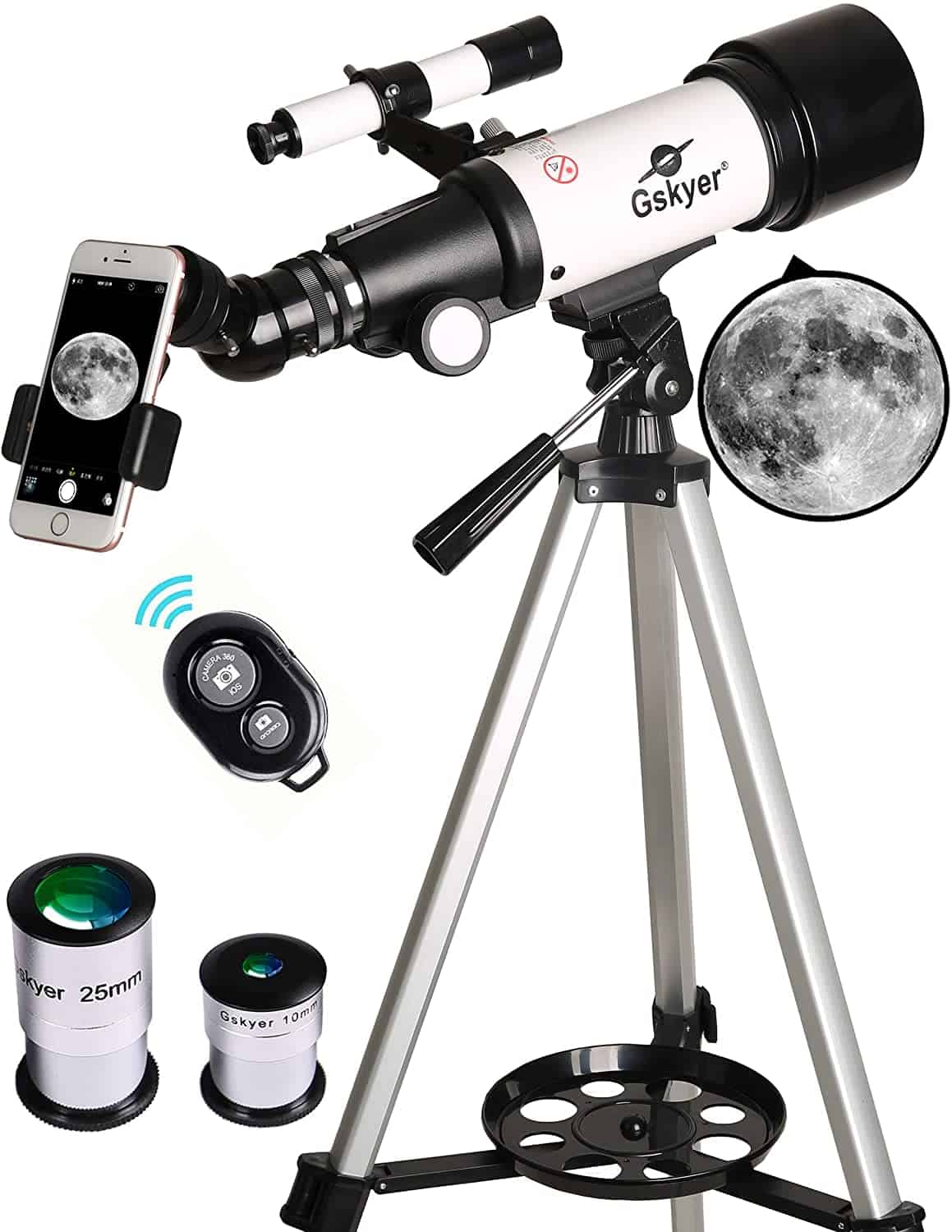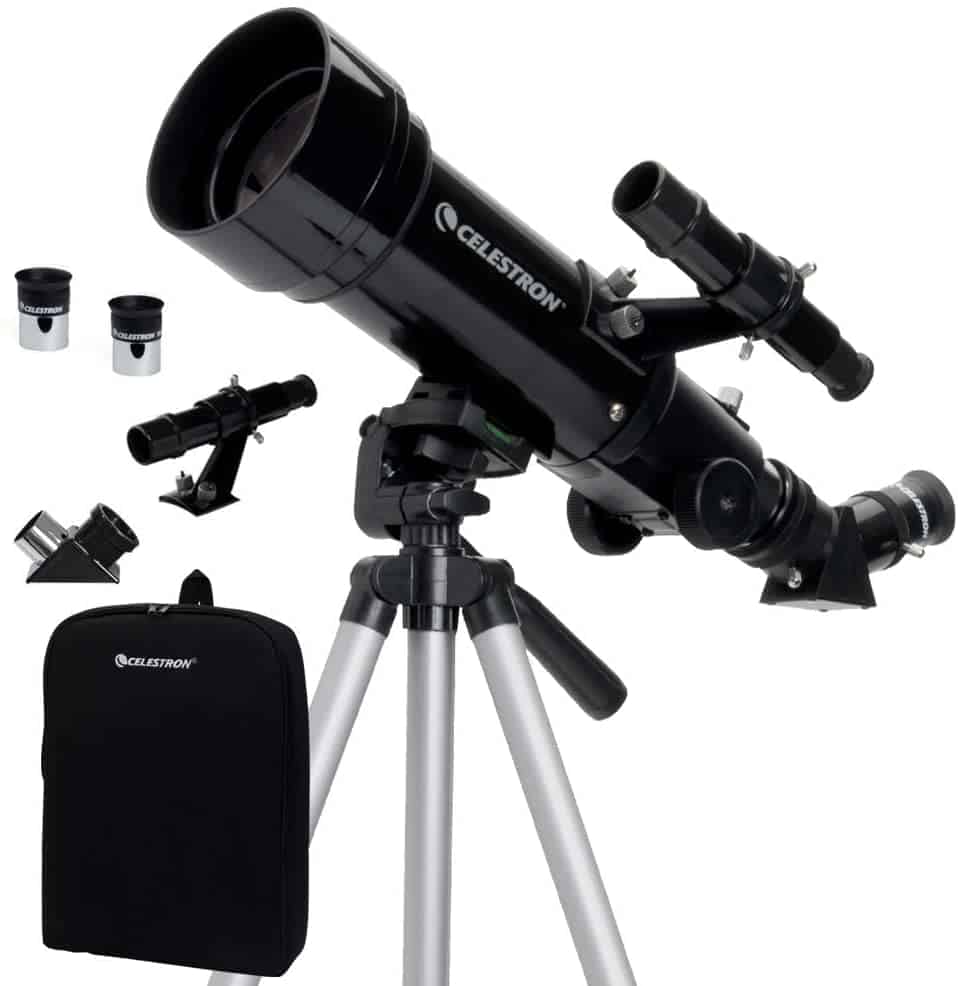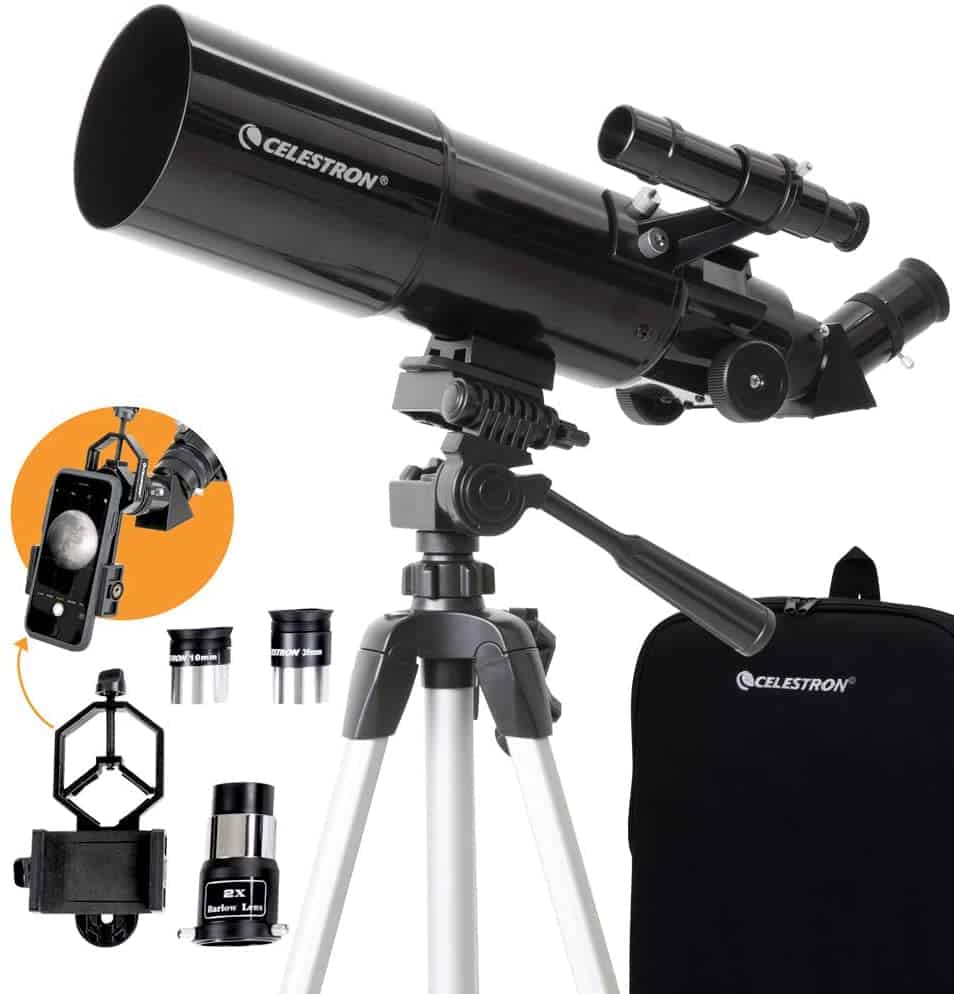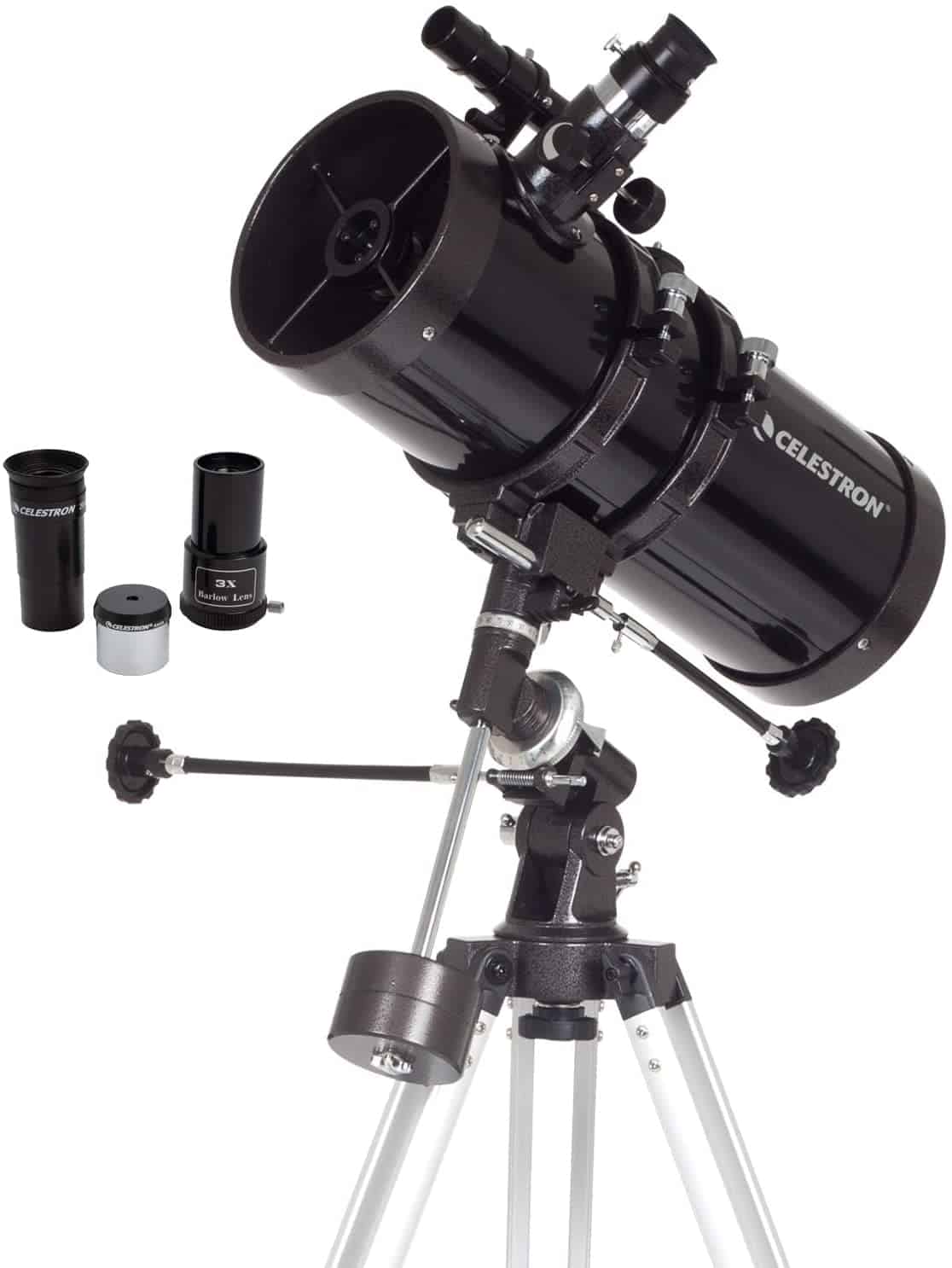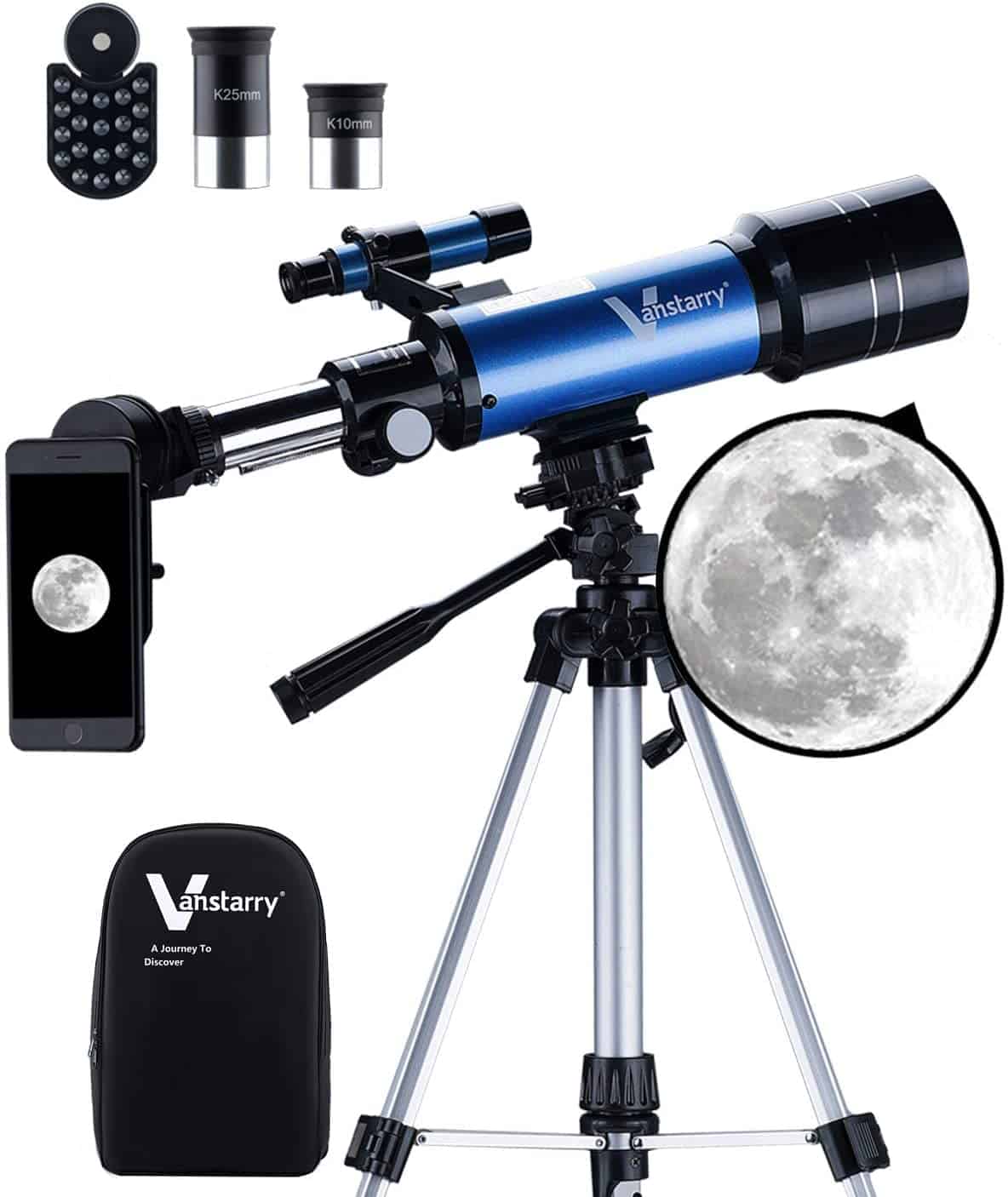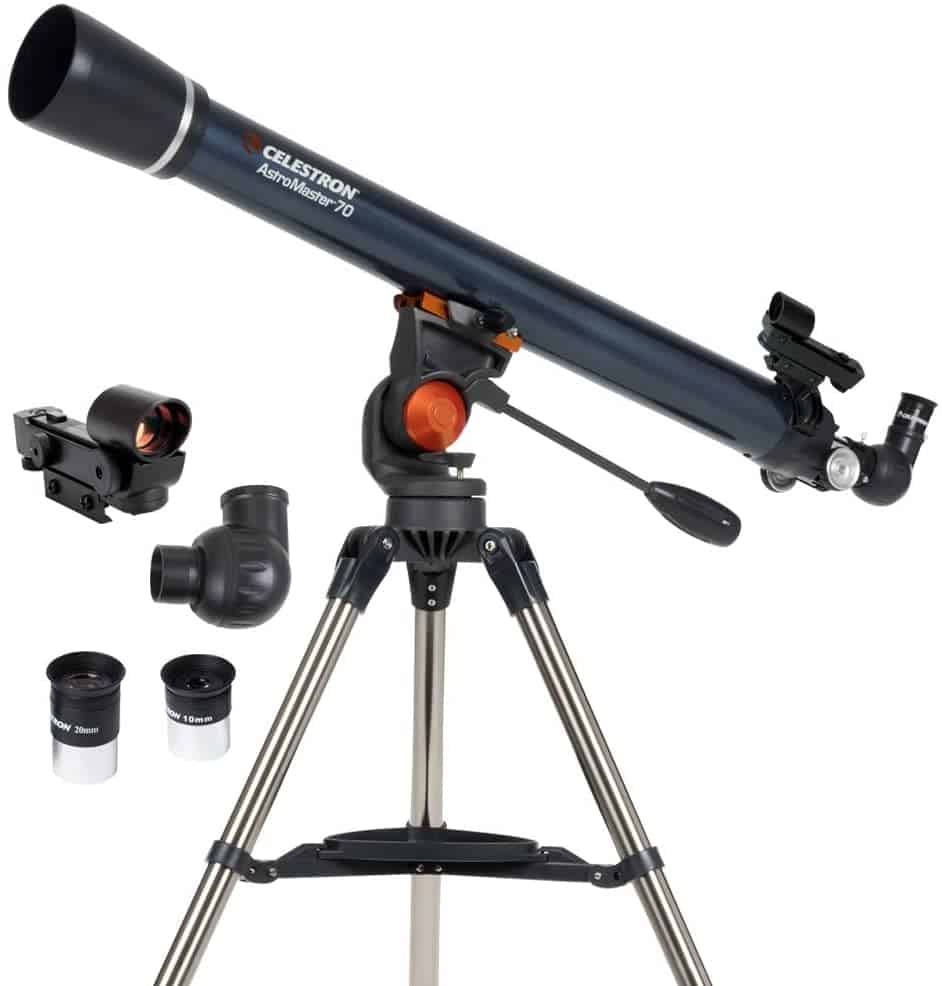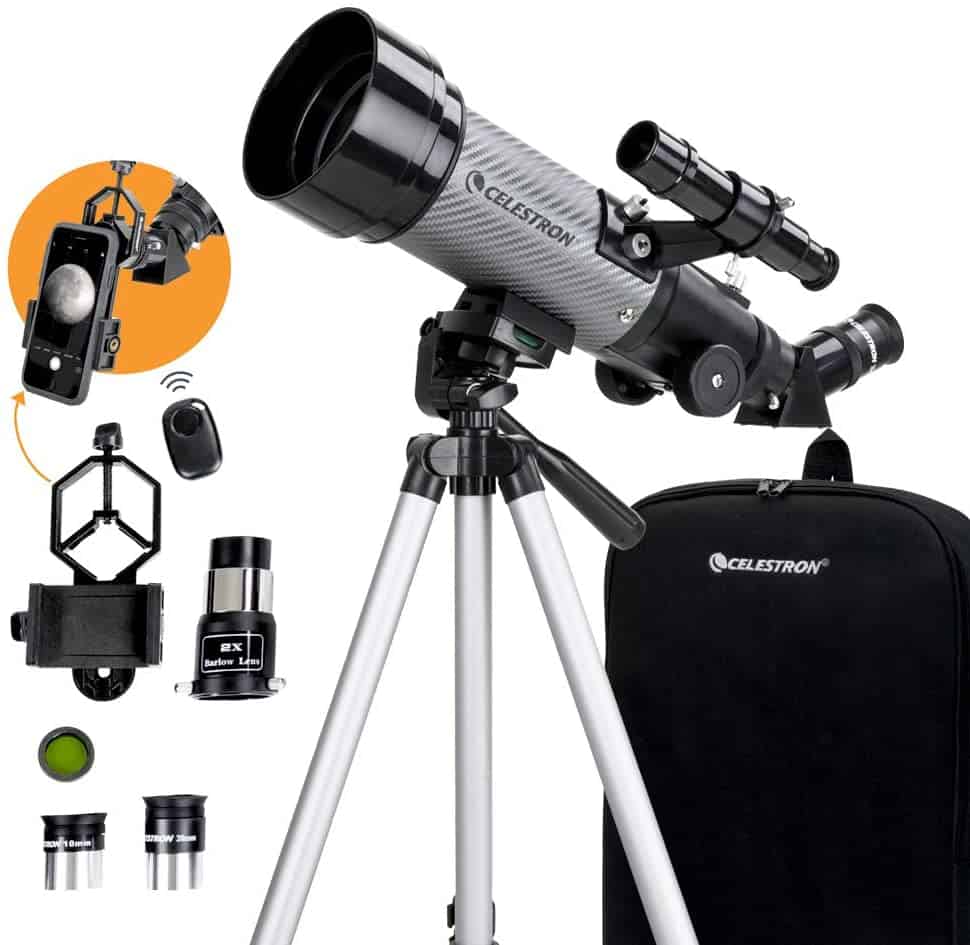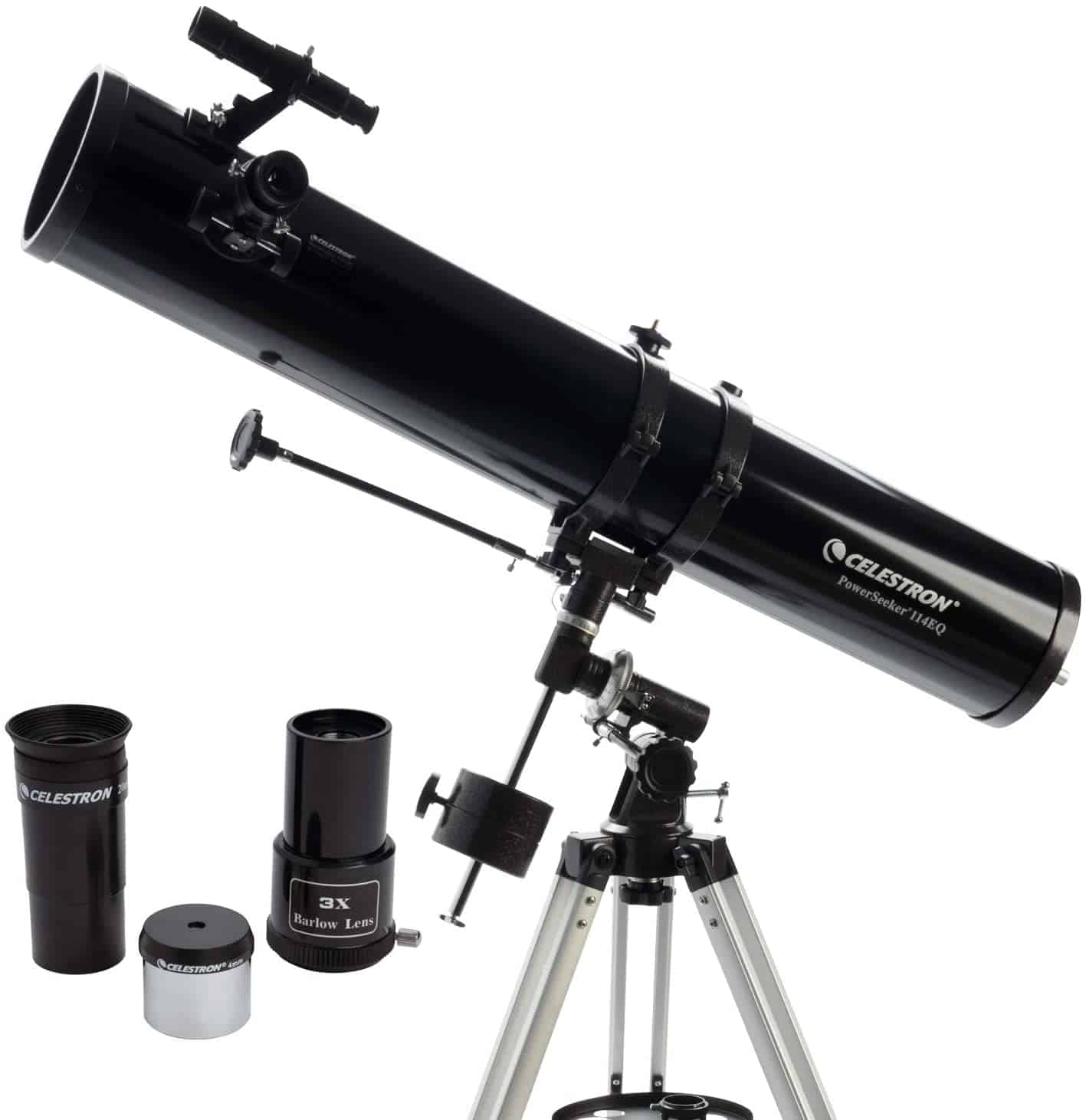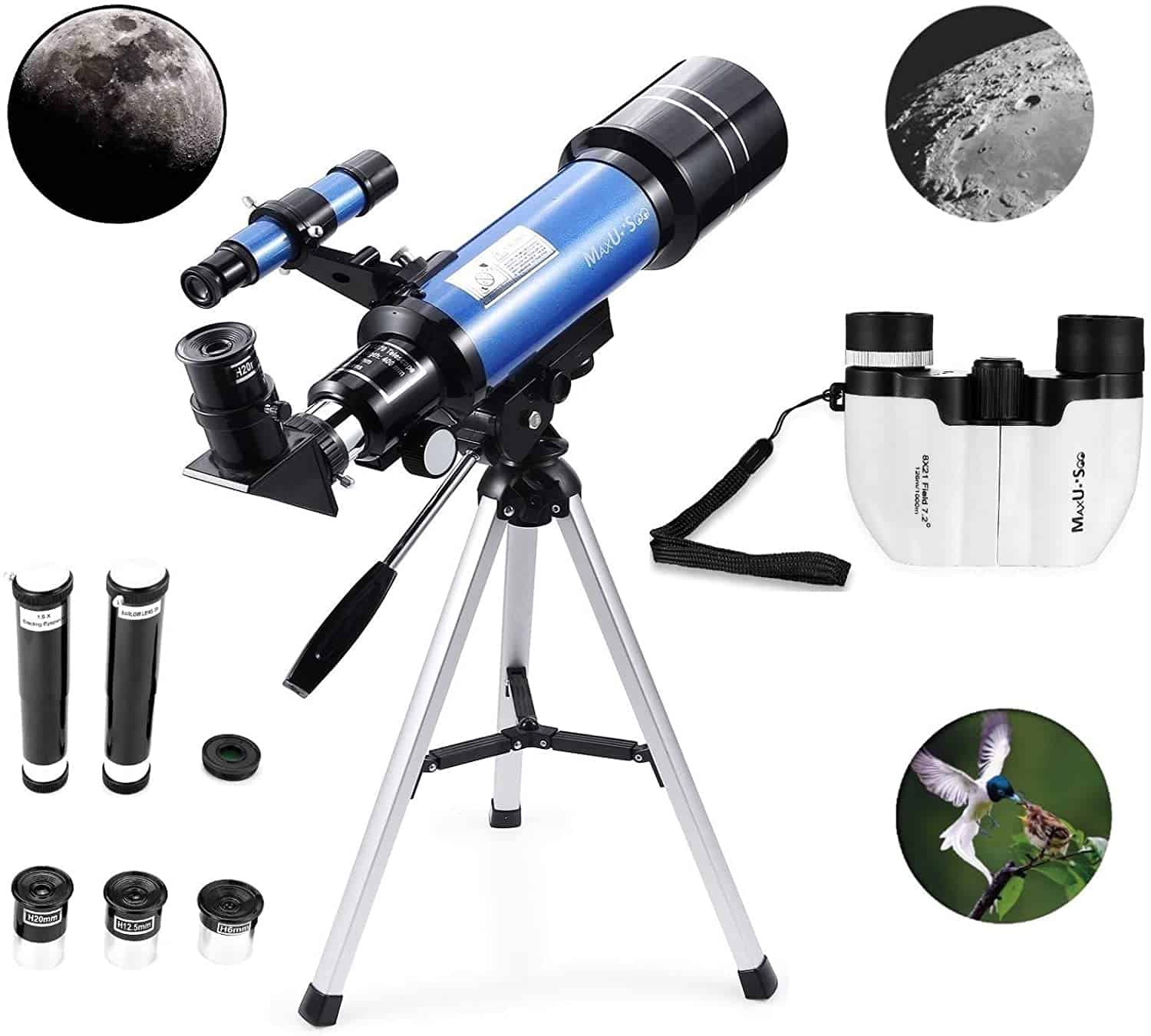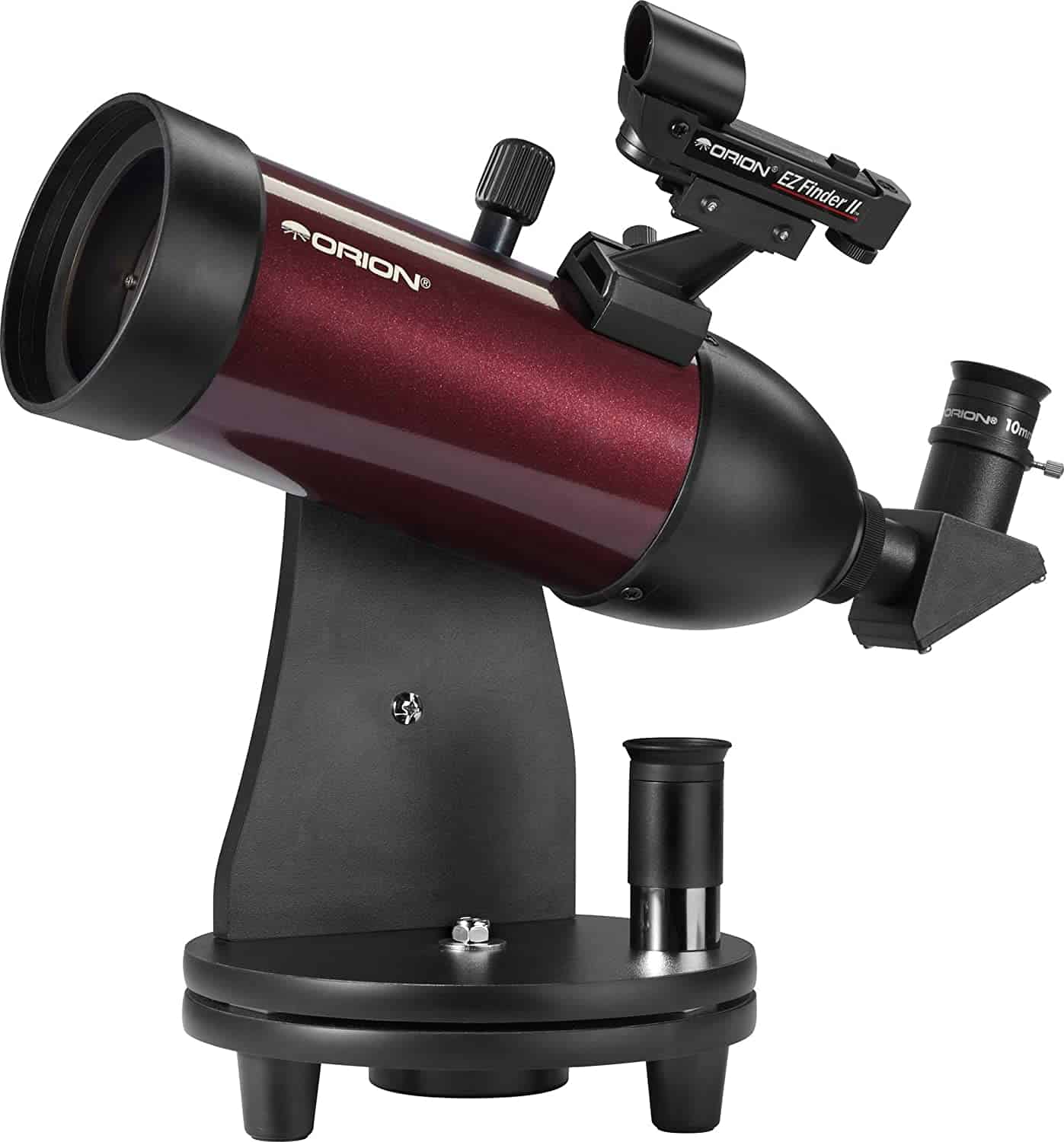Looking at celestial objects for fun or research purposes is one heck of a hobby. Telescopes are essential instruments for astronomers.
Although it is a lot of variety available online, not everything you like will be within your budget. But you don’t have to worry; there are several Best Telescopes under $200 that offer you a pleasant experience.
Take a look at the products that we have reviewed below to get the best quality product at an affordable price!
Our Overall #1 Rated Pick
If you are an on-the-go sky lover and gazer, the Gskyer telescope promises you a fantastic experience. With a 70mm objective lens, 400 mm focal length, and 120X magnification power, this telescope is a great Refractor Telescope.
One of the fascinating traits of this telescope is that it allows effortless assembly, making it easy for a beginner as well. Gskyer offers precise and high-resolution images. Being compact and handy for outdoor adventure, this telescope wouldn’t leave you in a lurch.
The 10 Best Telescopes Comparison Chart
Image | Product Name | Ranking | Price |
|---|---|---|---|
1 4.60 | |||
2 4.20 | |||
3 4.00 | |||
4 4.00 | |||
5 4.60 | |||
6 4.40 | |||
7 4.30 | |||
8 4.10 | |||
9 4.10 | |||
10 4.00 |
The 10 Best Telescopes Out There
In the section below, we will be walking you through ten of the most effective telescopes that are good for your wallet. Under $200, get ready to explore the mysteries that the sky holds!
If you are an on-the-go sky lover and gazer, the Gskyer telescope promises you a fantastic experience. With a 70mm objective lens, 400 mm focal length, and 120X magnification power, this telescope is a great Refractor Telescope.
One of the fascinating traits of this telescope is that it allows effortless assembly, making it easy for a beginner as well. Gskyer offers precise and high-resolution images. Being compact and handy for outdoor adventure, this telescope wouldn’t leave you in a lurch.
Gskyer features a 400mm focal length and 70mm aperture that provides clear and stunning images of your favorite celestial objects. The lens is covered with coatings that offer safety for your eyes.
Gskyer Telescope is not your ordinary sky-gazing tool. It comes up with a mounting bracket and cross-hair lines whose primary function is to help locate the objects quickly. With two eyepieces and a Barlow lens, the magnification power reaches 120X.
Another captivating characteristic of this telescope is that it consists of an adjustable aluminum tripod that makes the telescope flexible.
This telescope comes with a bag in which you can keep all the accessories. This makes it handy for all outdoor activities.
PROS
CONS
Are you looking for a telescope that satisfies your itch for stargazing without adding too much weight and is suitable for your pocket? A telescope that also protects your eyes while you get lost in the mysteries of the sky? Celestron Telescope is the answer.
This telescope works for both celestial and terrestrial viewing. With a lens of 70mm, Celestron allows you to have a sharper image of the distant object. It has two eyepieces and offers effortless assembly.
Featuring a 70mm objective lens and a high-quality coated glass optics, Celestron makes your Stargazing experience a dream come true. To make it handy for outdoor ventures, the apparatus comes with a backpack as well. With a backpack that can adjust both the telescope and the tripod, you can easily take it anywhere you want without feeling any extra weight.
Celestron Telescope is equipped with two high-quality eyepieces that aid in providing you a detailed look at the celestial objects. These eyepieces are 20mm and 10mm that are a source of low and high-power views of the sky both in the day and the night.
As far as the objective lens is concerned, the 70mm lens shows a bright and clear image of the targeted terrestrial objects as compared to the 50mm lens. It can magnify the targeted object to about 20x and 40x.
PROS
CONS
Allow us to introduce you to a telescope that promises you the best stargazing experience of a lifetime. This Celestron telescope has an objective lens of 80mm. Handy, high-resolution images, compact, and with powerful eyepieces, Celestron is a great telescope when you want to navigate the skies!
For the protection of eyes, the telescope has a high-quality coated glass optics. The objective lens is 80mm that provides high-resolution images. Celestron Telescope is equipped with two high-quality eyepieces that aid in providing you a detailed look at the celestial objects.
These eyepieces are 20mm and 10mm that are a source of low and high-power views of the sky both in the day and the night. If you are a beginner, you would have no problem assembling this apparatus, as no tools are required.
With a backpack in which you can keep both the telescope and the tripod, you can easily take it anywhere you want without feeling any extra weight. That’s a catch! Don’t you agree?
PROS
CONS
With an aperture of 127mm, this PowerSeeker 127 EQ Telescope has two eyepieces that offer the brightness and clarity of the object. The telescope is lightweight and portable as well.
PowerSeeker 127EQ is quite famous among beginners as it is easy to use. The telescope promises quality, durability, power, and value. An interesting trait is that the telescope consists of a German equatorial mount that provides the user with an accurate and smooth pointing. This Newtonian Reflector allows a flawless sky gazing experience.
Offering portability and accessibility, Celestron promises a lightweight and compact telescope that can be taken anywhere in the world to have a glance at your favorite planet. The Barlow lens multiplies the magnification power 3 times. The telescope also features two eyepieces (20mm and 4mm) to have a bright image of the targeted celestial object.
PROS
CONS
With a magnification power of 120x, Vanstarry Telescope is doing wonders for sky lovers. One of the most amazing traits of this telescope is that it includes the altazimuth mount whose primary function is to simplify tracking celestial objects. With the objective lens 70mm and focal length 400mm, Vanstarry Telescope is a must choice.
For the protection of eyes, this telescope comes with high-quality coated glass optics. As far as the objective lens is concerned, the 70mm shows a bright and clear image of the targeted terrestrial objects as compared to the 50mm lens.
Another captivating characteristic of this telescope is that it consists of an adjustable aluminum tripod that allows you to view from different angles. There are two eyepieces in Vanstarry (25mm and 10mm). Due to these eyepieces, the magnification power of the image can be enhanced to 16x and 40x, respectively.
PROS
CONS
If you are seeking a telescope that is durable and professionally designed, allowing your object to be magnified to 45x and 90x, Celestron AstroMaster 70AZ is a great choice.
The two eyepieces offer extreme magnification of the object and never leave you disappointed. It is very easy to assemble and is portable. AstroMaster assures that you have an amazing experience.
It protects your eyes by providing fully coated glass optics. The apparatus is lightweight and compact; hence, making it handy for outdoor ventures. For a better and a clear vision, Celestron AstroMaster features a powerful 70mm objective lens.
A lightweight frame ensures its portability. The apparatus is very easy to assemble, and you don’t need any tools.
You will find two eyepieces in this telescope (20mm and 10mm) that will never disappoint you while you stargaze!
PROS
CONS
Waiting for an ideal telescope that is perfect for both adults and kids? Wait no more. Celestron Telescope, with a 70mm objective lens and two pieces (20mm and 10mm), is at your disposal.
Featuring a 70mm objective lens and a high-quality coated glass optics, Celestron makes your Stargazing experience a dream come true. It has a compact design. Celestron Telescope is equipped with two high-quality eyepieces that aid in providing you a detailed look at the celestial objects.
These eyepieces are 20mm and 10mm that are a source of low and high-power views of the sky both in the day and the night.
Celestron can magnify the targeted object up to 80x. Tempting. Don’t you agree?
PROS
CONS
Two eyepieces, triple magnification power, user-friendly, perfect for all users- we give you Celestron PowerSeeker114EQ that can rock your world by showing you crisp images of the solar system, nebulas, galaxies, and your favorite planets. A good catch, don’t you think?
An exciting feature is that the telescope consists of a German equatorial mount that provides the user with accurate and smooth pointing. This Newtonian Reflector provides a flawless sky gazing experience.
Offering portability and accessibility, Celestron promises a lightweight and compact telescope that can be taken anywhere in the world to have a glance at your favorite planet.
Consisting of two eyepieces (20mm and 4mm), the Barlow lens multiplies the magnification power three times. PowerSeeker 114EQ is quite famous among beginners as it is easy to use. The telescope promises quality, durability, power, and value.
PROS
CONS
Doing wonders in science and astronomy while offering an ideal educational spirit for kids, MaxUSee is not your typical telescope. With three eyepieces, 70mm objective lens, and 400mm focal length, get yourself ready to find solace in the mysterious world of planets and nebulas.
This telescope is ideal for your kid as their minds are more curious than adults. MaxUSee features three pieces (6mm,12.5mm,20mm). For astronomy beginners and kids, this telescope offers easy setup. It is very tireless to carry it, hence, perfect for kids.
PROS
CONS
What is better than a compact and lightweight telescope with powerful optics and lets you observe the Moon craters, the rings of Saturn, the moons of Uranus- they might lose their mind. With two eyepieces and an 80mm objective lens, Orion Telescope allows you to explore the world that is above us to leave us startled.
Orion allows you to view your favorite sky furniture, including the moon, planets, nebulas, and cloudy clusters.
This amazing telescope comes up with two pieces (20mm and 10mm), allowing better imaging. Featuring a lightweight apparatus, you will never find it difficult to carry this telescope, whether you want to observe the sky from a mountain or your backyard.
This telescope allows more light to enter into the eyepieces than any 60mm lens, which means the chances to access your favorite nebula are high.
PROS
CONS
Buying guide
There are a few things you should keep in mind when looking for a telescope, whether you’re buying online or purchasing in person. Here are a few points discussed in detail to help in choosing your perfect telescope and start your celestial experience to help in the process.
So, let’s get started!
Aperture
In simpler words, an aperture is the small hole in the lens through which light passes and enters your eye through the eyepiece. The aperture is also known as the objective of the telescope. The aperture of the telescope needs to be large and adjustable.
A larger aperture will gather a lot of light and show a much brighter view of the celestial objects. The adjustable feature allows you to change the aperture opening enabling you to shift focus by compromising the brightness of the view.
If you’ve been into astronomy, you’ll know that the most common issue with viewing celestial bodies is not the sharpness of the view. The problem is the faintness of the body. And a small, faint celestial body does not need more magnification to be seen; it needs more light.
The larger size of the aperture addresses this issue and allows more light to enter, allowing more exposure and a brighter view.
The different types of telescopes feature apertures that brighten and magnify view in their way. Each with their pros and cons, of course.
Magnification
Some modern telescopes feature improved magnification. This range of magnification can be achieved by merely changing the eyepiece. All this is achievable only if the telescope features a large aperture. When more light enters the lens, there are more chances of achieving a more blatant and magnified view.
A smaller aperture will also allow you to magnify the image, but it will not be a sharp and clear image but somewhat blurry and unfocused. The magnification range of telescopes varies. Telescopes that feature around the 50X magnification feature are great at looking at the celestial bodies itself.
You will be able to visualize the moons of Jupiter and the rings of Saturn. Higher magnification is a must if you’re looking to the intricacies of Mars or crusts and marks of Venus. Around 150X should be best to view all the details.
Magnification highly depends upon the optical quality and observing conditions. Other than that, the length of the scope is also a contributing factor. For example, a moderate length of the telescope, say 6-inch will have better and greater magnification peak then a say 4-inch scope, all under ideal situations.
Focal length
Focal length and aperture go hand in hand. Focal length means the distance between the center of a lens or curved mirror and its focus. The lens whose focal length we are concerned about is that of the eyepiece.
A more extended focus will allow better viewing of planets and stars. It will be able to provide a much clearer and magnified view and is also easier to use for people with prescription glasses. So, it is better to look for a higher f/ratio. There are a few smaller f/ratio telescopes, but they are very costly, and cheaper ones just don’t cut it.
So, which is better? When looking at planets and Star up close, a longer focus will be best for you. A longer focus would be ideal for viewing intricacies and great details. If that is your intention, then you have your choice.
But if you wish to buy a telescope that will help you to see larger galaxies such as the milky way with all the sparkles and stuff, then a short focus is for you.
Better sparkly image is so because a shorter focus will allow you to view much more of the space and sky in one view. It all comes down to the purpose of the telescope and preference of the user.
Mounts
Mount is what holds the telescopic tube in place. There are two common types of mounts.
Equatorial mount
As the name implies, the equatorial mount allows you to have a movement of the scope on the axis of all four directions, namely, north to south and east to west. This feature allows you to follow the body as the earth moves about its axis.
New modern telescopes also feature a motor mount. This mount will enable you to have equatorial movement automatically. This mount is ideal for working in a specific star project or group project where you can’t be bothered to move the scope again and again.
Altazimuth mount
These tripod mounts move either up and down (altitude) and left and right (azimuth). These mounts are generally lighter as they do not need to support the scope via weights but do it via stand. Dobsonian mounts are one of the most well-known altazimuth mounts. Altazimuth, however, does not feature any motorized function, which means that manual movement is required.
Mounts, again, are a point of preference and what your work requires.
Eyepiece
The eyepiece is the portion of the scope that you look into to see the view; hence, the name “Eyepiece.” Eyepiece captures the light coming from the other end of the scope and forms and image inside the tube that we can see.
But, this image is not visualized as it is. We need another lens to magnify this image and project that image into our eye. The lens in the eyepiece does precisely that. Most telescopes feature a few eyepieces while some don’t. By changing the eyepiece, you can shift the magnifying power of the image.
The eyepiece, of course, also comes in a variety of different styles. Most expensive eyepieces feature several lenses within. Multi-element designs are ideal for broad field view and can even mimic the low f/ratio. Due to its precious nature, beginners stay away from intricate designs and lean towards old-fashioned eyepiece models.
Most telescopes include 1 to 2 eyepieces, but it is preferable to have a range of eyepieces. When looking for a single eyepiece, avoid full barrels (.96 inch) as this reflects the more inferior quality.
Finders
In easy words, a finder is an aiming device used in astronomy; typically, a small auxiliary telescope mounted on the main astronomical telescope along the same line of sight. When looking through a telescope, you really can’t tell where exactly you’re looking as it zooms into the sky.
This issue is what finder resolves. Finder helps to aim better. Keeping in view that this feature is helpful when the target you’re aiming for is visible with the naked eye. Only then will you be able to aim and magnify it for proper viewing.
Finders are usually available in 3 different types,
Lens-less peep sight, usually suitable for broad lens view.
Reflex sight, projects a red dot on the sky, for greater precision as to where you want to magnify.
Finderscopes, allow the most precise pointing ability.
Most telescopes feature their finderscopes mounted on the original telescope tube. However, it is necessary for a high-quality product that helps to focus and projects a sharp image. A low-quality finderscope will be useless. Finders have their perks, such as it helps to brighten and magnify the image and focus on the portion you want the telescope to focus on. However, finderscopes tend to invert the image, which can be unfavorable for some, especially glasses wearers.
Electric control
While many traditional telescopes have manual settings, modern telescopes have introduced the feature of computer induced telescopes. These telescopes come with a built-in computer that allows you to move and autofocus on your target automatically.
However, this feature demands a few extra bucks.
Types of telescope
Mostly, there are three types of telescopes that are available online. Three major and common types of telescope are below.
Reflector telescope
The most distinct feature of this telescope is the presence of a small mirror at the opposite end of the telescope to gather the light and project it onto the eyepiece for a more focused image. The larger aperture also allows more light to enter and hence, produces a brighter image. The open tube, however, requires constant maintenance.
Refractor telescope
A large lens at the front end of the telescopes focuses light on a mirror behind the lens in the tube to project the image into the eyepiece. Although the tube is closed and sturdy, the telescope is not ideal for faint objects as smaller aperture doesn’t allow much light to enter.
Compound telescope
Also known as a catadioptric telescope. These telescopes feature two mirrors on both ends that work with the lens to produce an HD outcome. It is a rather expensive and bulky model, mostly suited for labs.
Beginners choice
If you’ve recently started to take an astronomy interest and are new to the idea of a telescope, then a reflector or a refractor telescope would be a modest choice. Although the compound telescope is bulky, it is still the best for celestial object visualization.
FAQs
How do telescopes differ from one another?
Telescopes usually differ in their optics, design, mounting, and control. Position of lens and mirrors, the diameter of these lenses, type of mount, all these features help to distinguish each type of telescope from the rest.
Is a reflector telescope better or refractor?
Each to their own. Reflectors usually feature larger apertures with maximum light entering. This large aperture helps to portray a brighter image. On the other hand, refractor telescopes reduce light distortion or spikes, offering a much clearer image.
What telescope is best for planet and galaxy observation?
Reflector telescope is the best choice to opt for when observing galaxies and planets as they offer a more sharp and more precise image of planets and double stars.
Is the motor necessary for a telescope?
Telescopes do not need a motor function to work. It is an additional feature. If you’re going to be looking at a celestial body for a while, the earth’s rotation will lose the body, and you will have to set it again and again manually. A motor saves you from this recurring arrangement.
Why is a larger aperture preferred?
Larger aperture means that a larger hole is present. At the opposite end, this large hole is present to capture as much light as possible to ensure a sharp, clear, and brighter image in which at least some sorts of details are visible.
Final Words
Astronomy is arguably one of the most oriented and fun hobbies out there. Whether someone does it for research or just for fun, everyone is sure to be mesmerized by the beauty of burning stars and the giant planet.
Space is full of enormous balls of gases and humongous planets roaming about, and we have been unaware of them till a decade ago. These astronomical bodies, while so far away, can easily be seen from your bedroom window. The best telescope under $200 has opened the window for anyone to be able to see the complexities of our space and planets and stars that surround us, even on a budget.
I hope this guide helps you in choosing your very own telescope.
Happy gazing!

